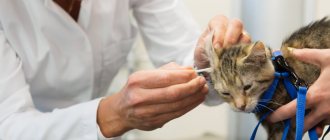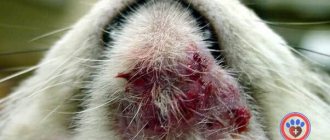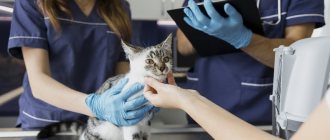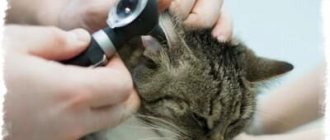Epilepsy in cats is a fairly rare disease. It is associated with disorders of the brain, which arises as a result of changes in the ratio of inhibition and excitation processes. It is characterized by periodic attacks that pass after a short period of time.
It is believed that signs of epilepsy most often appear in cats. Treatment for true epilepsy has not been developed, but there are drugs that can significantly reduce the frequency of manifestations.
Description of the disease
Epilepsy is diagnosed in only 0.5-1% of cats. This term refers to a neurological disorder characterized by the sudden onset of seizures. The disease occurs in a chronic form, and the seizures themselves are recorded on a regular basis.
Depending on the severity of the disease, cramps can be observed in individual limbs or throughout the body. They are caused by paroxysmal, or irritating, discharges in the neurons of the brain. In addition to humans and baleen pets, other mammals, including dogs and rodents, also suffer from the disorder.
Epilepsy: general concepts and features
Without electroencephalography, it is difficult to detect epilepsy. Basically, veterinarians have to be content with the presence of paroxysmal seizures, on the basis of which they differentiate diseases from pathologies with similar manifestations:
- disturbance of blood composition (hypoglycemic convulsions).
- brain tumor;
- seizures due to exposure of the retina to bright, flashing light.
Unlike true epilepsy, where two unprovoked seizures occur within 24 hours of each other, here they can occur in different ways. And of course, it would be a diagnostic error to claim epilepsy based only on the occurrence of convulsive phenomena without special studies.
Epilepsy occurs in various types in dogs and cats. In the practice of the Ros-Vet Center, we often have to deal with generalized convulsive seizures. Owners notice a sudden loss of consciousness in the pet, severe muscle tension, with twitching in the torso and limbs.
Often a seizure is different from the “norm”, it all depends on where the focus of convulsive activity is located in the brain and how “wrongly” the excitation will spread through the neurons.
Important! Often, veterinarians made a diagnosis based on only one symptom, which was strange for the breeder. Your dog catching flies that aren't actually there can be a symptom of epilepsy.
Causes of epileptic seizures in cats
Treatment methods and prognosis for future life depend on the causes of the pathology. They are divided into 2 large groups: congenital and acquired.
Congenital
From the name it is easy to guess that these reasons contribute to the development of the disease from birth, that is, from the first days of the animal’s birth. These include:
- intrauterine damage to the fetus due to head injuries, hypoxia and infection of the mother;
- inbreeding, or inbreeding;
- poor heredity, that is, the presence of at least one parent with confirmed epilepsy.
The prognosis for such reasons is unfavorable. The disease cannot be treated, so most often the animal is euthanized.
Purchased
Causes from this group affect the animal at a more conscious age. These include:
- brain tumors;
- various pathologies of internal organs (vessels, kidneys, heart, liver);
- prolonged stress;
- hormonal disorders (diabetes mellitus, hypocortisolism);
- traumatic brain injuries;
- bacterial and viral infections;
- poisoning with household chemicals, medicines, plants;
- avitaminosis (namely, a lack of vitamins responsible for the functioning of the nervous system).
In most cases, attacks go away after the underlying cause is eliminated.
At-risk groups
Most often, pathology is diagnosed in representatives of exotic breeds, as well as in males. Regardless of the cause, the first attacks appear no earlier than 5 months after birth.
Treatment of epilepsy
During diagnosis, the doctor determines the cause that provoked epilepsy attacks. If this is a disease, for example, diabetes, then treatment of the root cause is required. If it is not possible to completely cure the animal (and with true epilepsy this is impossible), then the risk of seizures can be reduced to a minimum. This will ensure the cat has a long life without suffering.
Drug treatment
True epilepsy cannot be treated. To reduce the number of attacks, the cat is prescribed Phenobarbital or Diazepam for life.
Phenobarbital belongs to a group of anticonvulsants that can simultaneously be a stimulant of the nervous system and reduce its excitability. Due to this, the pet's nerves become less sensitive, so that an attack requires a stronger impulse than before.
Phenobarbital is an anticonvulsant drug
At the initial stage of treatment, the dose of the drug is 1–2 mg per 1 kg of cat weight. Only a veterinarian can determine the exact dosage based on the research conducted. Phenobarbital should be taken twice a day.
The drug is quickly absorbed into the blood, but after taking it the cat becomes sleepy. This condition will persist for another 4–5 days after the start of treatment, after which the cat will be more active.
One of the disadvantages of the drug is an increased craving for food, which can cause your pet to gain weight, so you will have to follow a diet. Besides this, there are other side effects:
- intoxication in case of liver dysfunction;
- immune-mediated destruction of blood cells with simultaneous deactivation of bone marrow, resulting in no new cells being formed.
Therefore, when treating with Phenobarbital, constant monitoring of the pet’s health and regular examination by a veterinarian is necessary . This will avoid complications.
Phenobarbital is available in liquid and tablet form
Diazepam helps prevent serial epileptic seizures. The drug is not taken systemically, but only after the next attack. Diazepam helps to weaken the activity of the central nervous system, which reduces the reaction to stimuli.
The daily dose is 1–5 mg. Only a veterinarian can prescribe a more precise dosage, depending on the cat’s reaction to the components of the medicine.
There are two ways to administer the drug:
- orally;
- rectally.
Candles are used directly during an attack. 1 candle can calm an animal for up to 8 hours.
Diazepam should be given to a cat during an attack or immediately after it in order to prevent repeated attacks.
The choice of drugs can only be made by a veterinarian, since both Phenobarbital and Diazepam have many side effects, in particular they destroy liver cells, which can lead to disruption of its functions. Therefore, you first need to weigh all the risks and benefits. If attacks occur less frequently (less than once a month) and last up to 30 seconds, the doctor may refuse to prescribe medications. This is due to a large number of side effects, as well as the impossibility of objectively assessing the effectiveness of treatment.
Possibility of treatment with folk remedies
Alternative medicine is ineffective in this case. This is due not only to the impossibility of giving such medications to a pet (it is unlikely that a cat will calmly chew onions or drink any infusions), but also to the fact that herbs are not able to have such a strong effect on the nervous system as to reduce its sensitivity to prevent attacks.
Nutritional Features
There is no scientifically proven evidence that epileptic seizures are related to diet, but it was observed that cats that were on a gluten-free diet stopped having seizures. The fact is that cats are carnivores, which means their stomachs are not designed to digest gluten products, such as wheat. Gluten antibodies harm the brain of cats. Therefore, if there are no concomitant diseases, then the pet should be switched to a gluten-free diet. In this case, you need to ensure that the amount of carbohydrates is as low as possible, and that the basis of nutrition is proteins. And, naturally, the food should contain a sufficient amount of B vitamins, vitamin D, magnesium and calcium.
Proper care
Such animals can live a long time, and their quality of life can be quite high. The following can help with this:
- proper treatment;
- regular visits to the veterinarian;
- gluten-free diet;
- limiting the cat from stressful situations.
Actions during an attack
Correct actions during cramps will help minimize trauma. A short-term seizure itself is not dangerous for a cat (except for those cases when they are repeated too often), but the injuries that a cat can receive during seizures are dangerous. Therefore, during a seizure you need to:
- Place your pet on the floor away from stairs and pieces of furniture that could cause injury, which will help prevent injury.
- Wait for the attack to end. During this period, it is strictly forbidden to press the cat to the floor in an attempt to ease the convulsions. This action will not bring a positive result, but the owner may get injured. There is no point in fixing the tongue if the cat is lying on its side, the tongue will not stick into the larynx anyway. You can hold the cat's head, put your hand or pillow under it.
It is important to record when the attack began, what happened before it, the duration of the attack, and other information that may be useful to the doctor for treatment.
Features of treatment of pregnant cats
The attacks themselves do not affect the kittens’ health in any way. In rare cases, miscarriages are possible. If epilepsy is a consequence of a viral infection, then there is a risk of transmitting the disease to kittens.
When seizures occur in a pregnant cat, it is important to rule out the presence of:
- toxoplasmosis;
- viral leukemia;
- peritonitis;
- immunodeficiency.
Detailed symptoms of epilepsy in cats
In cats, the pathology manifests itself as epileptic seizures. They are focal and generalized. The first includes convulsive twitching of one part of the body without loss of consciousness, and the second includes convulsions throughout the body, accompanied by fainting.
IMPORTANT!
Recurrence of attacks more than once every 30 days is a dangerous sign that requires mandatory drug treatment.
Three stages of a seizure
All generalized seizures go through 3 stages, differing in different durations and accompanying symptoms. These include:
- Prodromal.
Lasts from 2-3 hours to 2-3 days. Characterized by a vague clinical picture. Most animals experience sleep disturbances, apathy and poor appetite.
- Aura.
Lasts 2-3 minutes. The cat becomes nervous, does not recognize family members and wanders aimlessly around the house, not oriented in space. Sometimes there is profuse salivation. Shortly before the attack, the pet begins to demonstrate hostility, reacting aggressively to stroking and any attempts to be picked up.
- Ictal.
Lasts from 2 seconds to 5 minutes. At this stage, an immediate seizure occurs, which is difficult to miss. The animal suddenly falls on its side and freezes. His breathing stops. The eyes either roll back or stare at one point, followed by dilation of the pupils. Under the influence of convulsions, intense movement of the paws is observed, as when running. Foam appears at the mouth. At this moment the cat can go under himself. His consciousness returns gradually. First, breathing is restored, then the muscles relax, and at the very end the ability to blink and move the pupils returns.
Particular attention should be paid to the postictal stage. It lasts from several hours to several days and occurs immediately after ictal. Despite the absence of pronounced signs, the usual state at this stage still does not occur. The pet appears lost and disoriented. Because of this, he may show aggression, hide, bump into objects, sway when walking, fall or suddenly jump up and rush around the house.
REFERENCE!
The main symptom of the postictal stage is increased appetite.
Status epilepticus
Despite the rather frightening symptoms, epilepsy is not life-threatening in itself. Really serious complications are caused by status epilepticus - a pathological condition characterized by a prolonged attack lasting more than 5 minutes - or a continuous alternation of seizures, between which the cat does not have time to recover.
Which cats are at risk?
A direct connection of this pathology with specific cat breeds cannot be traced, however, according to statistics, epilepsy is more often detected in representatives of exotic cat breeds than other cat breeds. In addition, male pets are more susceptible to this disease.
Kittens do not have attacks of the disease at an early age. Seizures, if we are talking about a congenital form of the disease, appear no earlier than the animal is 5 months old.
The danger of epileptic seizures in cats
Status epilepticus leads to serious stress on the brain, provoking the development of other dangerous neurological disorders due to prolonged oxygen deprivation. It also shortens life expectancy, so ignoring it can lead to the death of the animal.
Frequent seizures affect behavior. The cat becomes less active and more irritable. The danger is also noted at the time of immediate convulsions. Due to loss of consciousness, the pet can be seriously injured by falling from a great height or hitting foreign objects.
Symptoms:
- convulsive movements;
- mental disorders;
- disorders of sound, taste, smell.
Complex partial seizures
Characteristic symptoms are a simple attack, but with impaired consciousness. “Automatic” behavior is noted: fiddling with clothes, buttons, wandering without purpose, a grimace may be distorted on the face, the jaw may perform chewing movements. They can become secondary generalized.
Secondary generalized seizures
Complex seizures with the spread of the epileptic discharge to both hemispheres of the brain. Sudden loss of consciousness, before this there may be a sensation of an aura, but not always. There may be convulsive muscle movements. In this case, the period of loss of consciousness can be very short and unnoticeable even for the patient himself.
Types of pathology
Depending on the cause, pathology is divided into 2 types: congenital and acquired. The first accounts for 30% of all detected cases. It is extremely difficult to diagnose and cannot be treated.
The acquired variety develops under the influence of external and internal environmental factors after the birth of the animal. In most cases, it has a favorable prognosis and recedes soon after the root cause is eliminated.
Nonconvulsive manifestations
These are the most difficult seizures to diagnose.
Can occur in children and adults. Symptoms can manifest themselves in the form of mental pathology - clouding of reason. This form responds very poorly to drug therapy. Symptoms:
- short-term attacks with “switching off” consciousness;
- change in facial expressions;
- vivid manifestations of pathological joy or negative emotions: rage, even suicide;
- delirium, visual hallucinations, confusion and nonsense of speech.
This form of the disease is the most dangerous, because it is often undiagnosed and untreated.
How is the diagnosis carried out?
If you witness an epileptic attack in a cat, be sure to contact your veterinarian. Thanks to timely diagnosis, the complications listed above can be avoided.
Examination of the animal and conversation with the owner
After a visual examination, temperature measurement, palpation of the abdomen and other basic manipulations, the veterinarian will need to collect an anamnesis, that is, all information related to the condition of the sick pet. This point is very important in making a diagnosis, so be sure to describe what happened in every detail, not forgetting to mention the duration of each stage and the events preceding them.
ADVICE!
If you see something unusual, shoot it on camera. Video recording will prevent you from missing an important point during a conversation with a doctor.
Separately describe all your pet’s chronic diseases, as well as those that have long been cured. If you have information about the cat's parents, you should also provide them.
Laboratory research
After collecting an anamnesis, clinical and biochemical tests of urine and blood are taken from the animal, as well as a blood sugar test. Based on their results, the presence of inflammation, intoxication, anemia, diabetes mellitus, as well as various abnormalities in the functioning of the liver and kidneys is determined.
Ultrasound and X-rays are used to check the functionality of major organs and systems, as well as hidden injuries. Brain functionality is checked using an electroencephalogram. If necessary, two more studies are added to the listed studies: CT and MRI.
REFERENCE!
In the absence of obvious causes of the pathology, the pet is diagnosed with “idiopathic epilepsy,” that is, primary.
Diagnostic algorithm
It is mandatory to collect an anamnesis, the history of the animal’s life and the occurrence of epilepsy. The owner needs to describe in detail in what cases the seizures begin, what accompanies them, and how much the duration of the seizures has increased compared to the initial manifestation.
Neurological examination (CT, MRI), clinical examination and laboratory diagnostics. This way you can exclude a tumor, destructive changes in the brain, and various anomalies in the body.
When no changes or neoplasms are found during the research, no facts of infectious lesions or previous illnesses have been established, and the possibility of poisoning has been excluded, then a neurologist can first make a diagnosis of “true epilepsy.” To confirm it, you will finally need an EEG (electroencephalography), which is carried out in the phase of deep anesthesia or under heavy sedation.
First aid for a pet
It is important to understand that due to disorientation and loss of consciousness, the animal can be accidentally injured. During a seizure, only the owner who is nearby can help him, so try not to panic and act as calmly as possible.
What should the owner do during an attack?
First, try to catch the stage of the aura. If you succeed, create the most comfortable and safe conditions possible using the following recommendations:
- Draw the curtains, dim the lights, turn off noisy appliances and open the windows to create a quiet environment and bring oxygen into the room.
- Place a sheet, oilcloth or absorbent diaper on the floor and carefully place the cat there so that he is on his side. In this position, there is no risk of tongue sticking, so do not try to stick your fingers or anything else into the mouth.
- Remove all potentially dangerous objects (products with sharp edges, heating surfaces) located nearby.
Never yell at your cat or use brute force on him. Punishments will only make his condition worse.
During an attack, be sure to hold your pet's head so that he does not choke on foam, saliva or vomit. Avoid holding. Pressing down to the floor to artificially suppress convulsions is fraught with dislocation or fracture of the limbs.
After the seizure ends, place water and food near the cat, but do not pick him up. Wait for the pet to fully come to its senses and come to you on its own.
When urgent veterinary help is needed
Urgent veterinary assistance is required for a prolonged attack of more than 5 minutes, a series of seizures without restoration of consciousness, and injury. In such cases, you should make an appointment for an examination on the same day or the next - or call a doctor directly to your home.
Mandatory examination is also necessary for those who are experiencing epilepsy for the first time. Despite this, in this case, in the absence of the listed complications, you can wait a little with an appointment at the veterinary clinic.
Treatment and supportive care
Epilepsy in cats can be treated at home. With the acquired variety, therapy is based on eliminating the root cause. If convulsions are observed frequently, then the animal must be prescribed anticonvulsants. In milder cases, sedatives are sufficient to relax the body.
In addition to taking medications, proper nutrition plays an important role. The easiest way is to switch your pet to ready-made food for epileptic cats. Most of its composition comes from proteins, and a smaller part from grains and other carbohydrates.
Prevention
What should be done for preventive purposes:
- Vaccinate kittens against diseases that can cause epilepsy.
- Protect the animal from contact with poisonous and toxic substances as much as possible. Including chemicals for cleaning the apartment.
- Do not leave your pet unattended.
- It is worth protecting your pet from stressful situations. For example, collisions with a dog.
All this cannot give an absolute guarantee that epilepsy will bypass the cat, but it will help to significantly reduce the risk of developing the disease.
Forecasts for future life
With an incurable form of the pathology, the cat remains epileptic for life. In this case, the owner needs to minimize the main provoking factors (loud sounds, flashing bright lights), improve the quality of life of his pet and protect him from injury. If successful, these measures can help achieve lasting remission and reduce the frequency of seizures.
“ Try to avoid stressful situations. If you were planning a move or renovation, then for the sake of your pet’s health you will have to postpone them.
Electrical stimulation of the vagus nerve
This type of treatment is prescribed as an additional method of therapy.
In many countries it is an adjuvant treatment method. It reduces the number of partial seizures in children and adults. Therapy helps prevent the abnormal activity that leads to seizures.
An electrical pulse generator is used and inserted under the collarbone or under the skin near the armpit. The electrode is attached to the vagus nerve. This method allows to reduce the frequency of seizures in patients.









